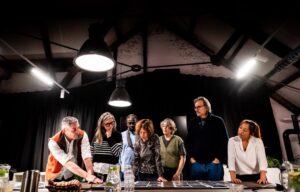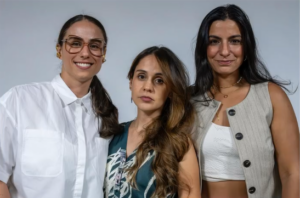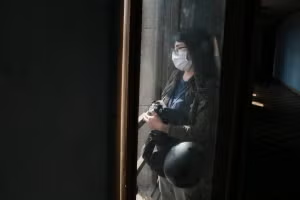Venezuelan photojournalist Gabriela Oraa was awarded first place by World Press Photo on May 16 in the individual category for the South America region, thanks to her photograph “The Last Hope.”
The image shows Venezuelan opposition leader María Corina Machado greeting a crowd of supporters from the roof of a vehicle, with followers stretching their hands out toward her. The photo, rich in vibrant colors, is named after a phrase that, according to Oraa, she heard over and over from followers: “María Corina, you are our last hope.”
“With rarely granted access in Venezuela,” the jury said, “this photo captures a significant political moment that no other photographer could have documented, highlighting Machado’s connection with her supporters.”
For the third consecutive year, the organization — which recognizes and celebrates the best in photojournalism and documentary photography — has honored a female Venezuelan photojournalist. In 2023, the award went to Fabiola Ferrero, and in 2024 to Adriana Loureiro Fernández.
However, the path has not been easy for any of them in a profession where women remain significantly underrepresented. According to data from Women Photograph, an organization that monitors the representation of women and nonbinary people in the industry, only 21 percent of photographs published in major media outlets in 2023 were taken by women or nonbinary photographers. In 2017, that figure was just 13.4 percent.
The study included outlets such as The New York Times, The Wall Street Journal, The Washington Post, Los Angeles Times, The San Francisco Chronicle, The Globe and Mail, Le Monde and The Guardian.

World Press Photo 2025 Jury deciding the winners (Photo: World Press Photo)
And although World Press Photo has recorded a slight increase in submissions from women, there is still a long way to go to achieve gender parity. For the 2024 edition, some 77 percent of participants identified as men and only 22 percent as women—a 3-point increase from 2021, when 19 percent of entries came from people who identified as women.
“Women think and process things differently from men, and that undoubtedly influences how we interpret situations and make decisions when we are covering a story,” Oraa said in an interview with the Roberto Mata photography workshop. “I am probably one of the few women who would say that being a woman in this profession has some advantages, especially when it comes to gaining access to people. However, I would be lying if I said there have not been challenges along the way.”
LJR interviewed three photojournalists who have covered conflicts in Venezuela, El Salvador and Peru to learn how they navigate the challenges of practicing this profession as women in Latin America.

From left to right, photojournalists Fabiola Ferrero, Gabriela Oraa and Adriana Loureiro Fernández. (Photo: Center for Photographic Research and Studies Venezuela)
There is an idealization of the photographer as a male adventurer, a Rambo-type who goes into dangerous areas to get the story, according to Ángela Ponce, a documentary photojournalist based in Peru.
“This is a masculinized job and most stories are told through a macho lens,” she told LJR. “There is always that perception that women are less capable in harsh or dangerous environments, and that simply being a man gives you some kind of innate ability.”
Ponce said this perception has negatively affected her career, both in international and local media. Even though she has been trained to cover violence, she has had to deal with condescending attitudes from male colleagues.
“Some colleagues covering marches or violent situations would say to me: ‘Don’t worry, stay close to me and I’ll take care of you,’” Ponce recalled. “And they did not say it out of camaraderie but because, as a woman, they think they have to protect me, as if I do not have the same skills they do.”
That macho perception has also been experienced by Fabiola Ferrero in Venezuela. “One time, someone made a ‘joke’ asking where my other lens was, if I had it in my cleavage, because that day I did not wear a loose shirt like I usually do,” she said.
In El Salvador, the presence of women photojournalists has grown slowly in recent years, according to what Jessica Orellana, who in 2020 co-founded ImPrudencia Colectiva, the first group of Salvadoran women photographers, told LJR.

“There is always that perception that women are less capable in harsh or dangerous environments, and that simply being a man gives you some kind of innate ability,” said Ángela Ponce, a documentary photojournalist based in Peru. (Photo: Courtesy)
“That was when we realized that many of our role models were men,” Orellana said. “It has only been about five years since we have seen more women working in photojournalism in El Salvador.”
Nevertheless, there are still prominent outlets where there are no women on the photography team, and in international agencies, their presence is occasional. “It took me eight years to get where I am now,” said Orellana, who currently freelances for outlets such as Reuters, German Press Agency, El País and Foreign Policy.
Ponce remembers that 10 years ago, when she started working at a local outlet in Lima, only five of the 30 photographers were women. “Later, the editors started giving more opportunities, but we have never reached 50/50,” she said.
This inequality also shows in relationships with sources. Many times, communities are surprised to see a woman photographer in conflict situations.
“Sometimes the people I photograph or interview do not understand why a woman would be in those places. They often ask me where my husband is,” Ferrero said.
Despite these challenges, all of them agree that being a woman can allow for a different and valuable kind of access. “For example, if I go to the home of a woman who has gone through a violent situation, it is easier for her to let me in and to have that more intimate look,” said Ponce. “In the case of men, building that trust takes more time.”